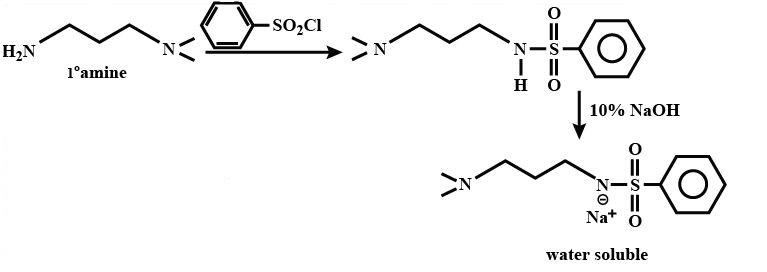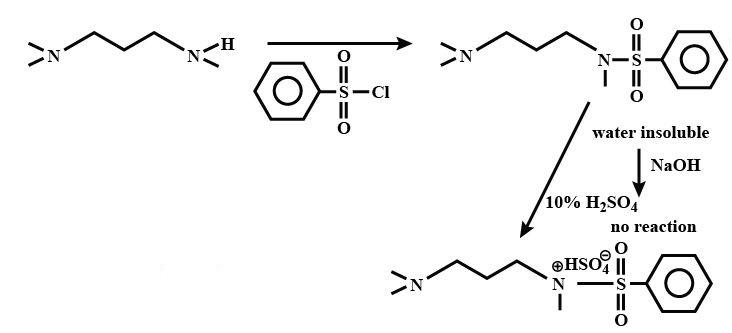
The Hinsberg test of a compound,
(A)
(B)
(C)
(D)
Answer
496.5k+ views
Hint: Heisenberg’s test is used to differentiate between primary amine, secondary amine and tertiary amine.
The reagent used for this reaction is phenyl sulfonyl chloride which can be prepared at the time of the reaction and can be a compound or a mixture of compounds.
Complete answer:
Let us discuss the Heisenberg’s test in detail,
This test is primarily used to differentiate within primary, secondary and tertiary amines. The amines here, acts as a nucleophile which attacks an electrophile i.e. Heisenberg’s reagent (benzene sulphonyl chloride).
Primary amine-
When Heisenberg’s reagent reacts with primary amine it gives a sulphonamide product which is soluble in alkali.
Secondary amine-
The reaction of Heisenberg’s reagent with secondary amine gives a sulphonamide which is insoluble in alkali but is water-soluble in the acid.
Tertiary amine-
There is no reaction in between tertiary amine and Heisenberg’s reagent.
Thus, this test is used for the differentiation of amines on the basis of the solubility of the obtained product in alkali.
Illustration-
In the given illustration we can see that,
Option (A) and (C) are primary amines; option (D) is tertiary amine. Hence, in accordance with the above given explanation only option (B) will satisfy the criteria as it is a secondary amine.
We can easily specify this by the reactions as follows,


Therefore, option (B) is correct.
Note:
The terms used to classify amines as primary, secondary and tertiary are derived in very different form than that of other classifications as of alcohols or alkyl halides. During the classification of amines, these terms are used to refer to the number of alkyl substitutes directly bonded to N-atom.
The reagent used for this reaction is phenyl sulfonyl chloride which can be prepared at the time of the reaction and can be a compound or a mixture of compounds.
Complete answer:
Let us discuss the Heisenberg’s test in detail,
This test is primarily used to differentiate within primary, secondary and tertiary amines. The amines here, acts as a nucleophile which attacks an electrophile i.e. Heisenberg’s reagent (benzene sulphonyl chloride).
Primary amine-
When Heisenberg’s reagent reacts with primary amine it gives a sulphonamide product which is soluble in alkali.
Secondary amine-
The reaction of Heisenberg’s reagent with secondary amine gives a sulphonamide which is insoluble in alkali but is water-soluble in the acid.
Tertiary amine-
There is no reaction in between tertiary amine and Heisenberg’s reagent.
Thus, this test is used for the differentiation of amines on the basis of the solubility of the obtained product in alkali.
Illustration-
In the given illustration we can see that,
Option (A) and (C) are primary amines; option (D) is tertiary amine. Hence, in accordance with the above given explanation only option (B) will satisfy the criteria as it is a secondary amine.
We can easily specify this by the reactions as follows,


Therefore, option (B) is correct.
Note:
The terms used to classify amines as primary, secondary and tertiary are derived in very different form than that of other classifications as of alcohols or alkyl halides. During the classification of amines, these terms are used to refer to the number of alkyl substitutes directly bonded to N-atom.
Recently Updated Pages
Master Class 12 Biology: Engaging Questions & Answers for Success

Master Class 12 Physics: Engaging Questions & Answers for Success

Master Class 12 Business Studies: Engaging Questions & Answers for Success

Class 12 Question and Answer - Your Ultimate Solutions Guide

Master Class 11 Accountancy: Engaging Questions & Answers for Success

Master Class 11 Physics: Engaging Questions & Answers for Success

Trending doubts
When was the first election held in India a 194748 class 12 sst CBSE

What are the major means of transport Explain each class 12 social science CBSE

Savarkar was released from jail in the year A1889 B1905 class 12 social science CBSE

State Snells first and second law of refraction class 12 physics CBSE

How do you convert from joules to electron volts class 12 physics CBSE

What is the importance of evolution class 12 biology CBSE




